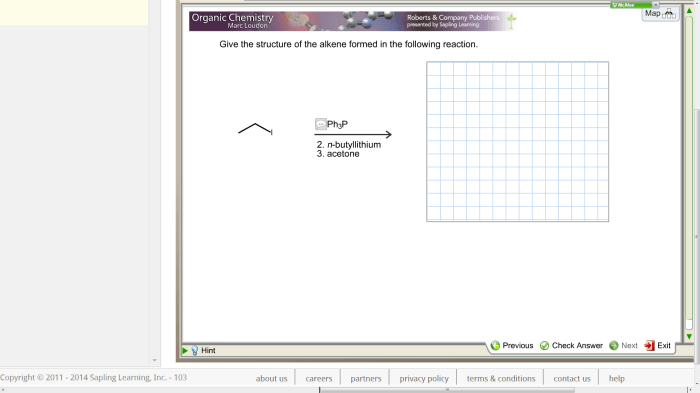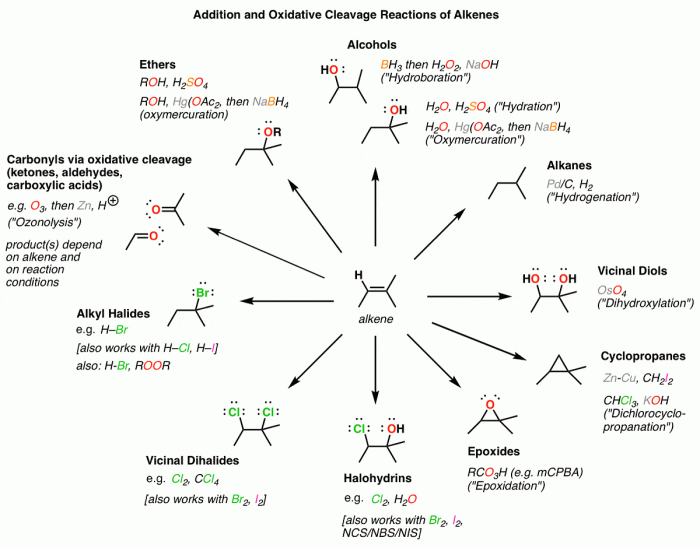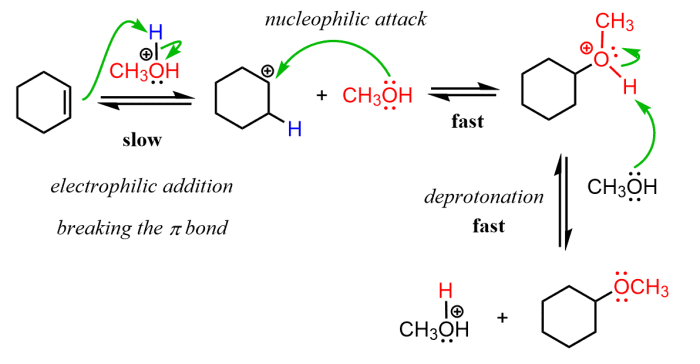Give the structure of the alkene formed in the reaction. – Understanding the structure of alkenes formed in reactions is crucial in organic chemistry. Alkenes, characterized by their carbon-carbon double bonds, play a significant role in various chemical processes and industrial applications. This article delves into the mechanisms of alkene formation, spectroscopic techniques for structural determination, stereochemistry, and their diverse applications.
The formation of alkenes involves elimination reactions and dehydration reactions, facilitated by specific reagents and catalysts. Spectroscopic techniques like IR, NMR, and mass spectrometry aid in identifying alkene functional groups and substitution patterns. Stereochemistry, encompassing cis-trans isomerism and E-Z nomenclature, influences alkene properties and reactivity.
1. Introduction

Alkenes are a class of unsaturated hydrocarbons characterized by the presence of at least one carbon-carbon double bond. The structural formula of an alkene is CnH2n, where n ≥ 2. The double bond consists of one sigma bond and one pi bond, resulting in a planar molecular geometry.
Alkenes are highly reactive due to the presence of the double bond, which can undergo a variety of reactions, including addition, oxidation, and polymerization. The structure of an alkene is crucial in determining its reactivity and physical properties.
2. Mechanism of Alkene Formation, Give the structure of the alkene formed in the reaction.
Alkenes can be formed through various methods, including:
- Elimination reactions:These reactions involve the removal of two atoms or groups from adjacent carbon atoms, resulting in the formation of a double bond. Examples include dehydrohalogenation and dehydration reactions.
- Dehydration reactions:These reactions involve the removal of water from an alcohol to form an alkene. Dehydration reactions are typically catalyzed by acids.
The choice of method for alkene formation depends on the starting materials and the desired product.
3. Structural Determination of Alkenes
The structure of an alkene can be determined using various spectroscopic techniques:
- Infrared (IR) spectroscopy:IR spectroscopy can be used to identify the presence of a double bond, as it gives a characteristic peak in the region of 1620-1680 cm -1.
- Nuclear magnetic resonance (NMR) spectroscopy: 1H NMR spectroscopy can be used to determine the number and types of hydrogen atoms attached to the double bond, while 13C NMR spectroscopy can be used to determine the number and types of carbon atoms in the double bond.
- Mass spectrometry:Mass spectrometry can be used to determine the molecular weight of an alkene and to identify characteristic fragmentation patterns.
By combining the results of these spectroscopic techniques, it is possible to determine the structure of an alkene.
4. Stereochemistry of Alkenes
The stereochemistry of an alkene refers to the spatial arrangement of the atoms around the double bond.
- Cis-trans isomerism:Cis-trans isomerism occurs when two groups are attached to the same carbon atom of the double bond. In a cis isomer, the groups are on the same side of the double bond, while in a trans isomer, the groups are on opposite sides.
- E-Z nomenclature:The E-Z nomenclature system is used to specify the stereochemistry of alkenes. The E (entgegen) descriptor is used when the groups of higher priority are on opposite sides of the double bond, while the Z (zusammen) descriptor is used when the groups of higher priority are on the same side.
The stereochemistry of an alkene can have a significant impact on its physical and chemical properties.
5. Applications of Alkenes
Alkenes have a wide range of industrial and biological applications:
- Industrial uses:Alkenes are used in the production of plastics, fuels, and solvents. Ethylene, the simplest alkene, is the most widely produced organic compound in the world.
- Biological significance:Alkenes are found in many biological molecules, including plant hormones and vitamins. They also play a role in cell signaling and metabolism.
The versatility of alkenes makes them essential to a wide range of industries and applications.
FAQ Compilation: Give The Structure Of The Alkene Formed In The Reaction.
What are the different methods of alkene formation?
Alkenes can be formed through elimination reactions, such as E2 and E1 reactions, and dehydration reactions, involving the removal of water molecules.
How can we determine the structure of alkenes?
Spectroscopic techniques like IR, NMR, and mass spectrometry provide valuable information about alkene functional groups and substitution patterns.
What is the significance of stereochemistry in alkenes?
Stereochemistry influences the physical and chemical properties of alkenes, affecting their reactivity and biological activity.


